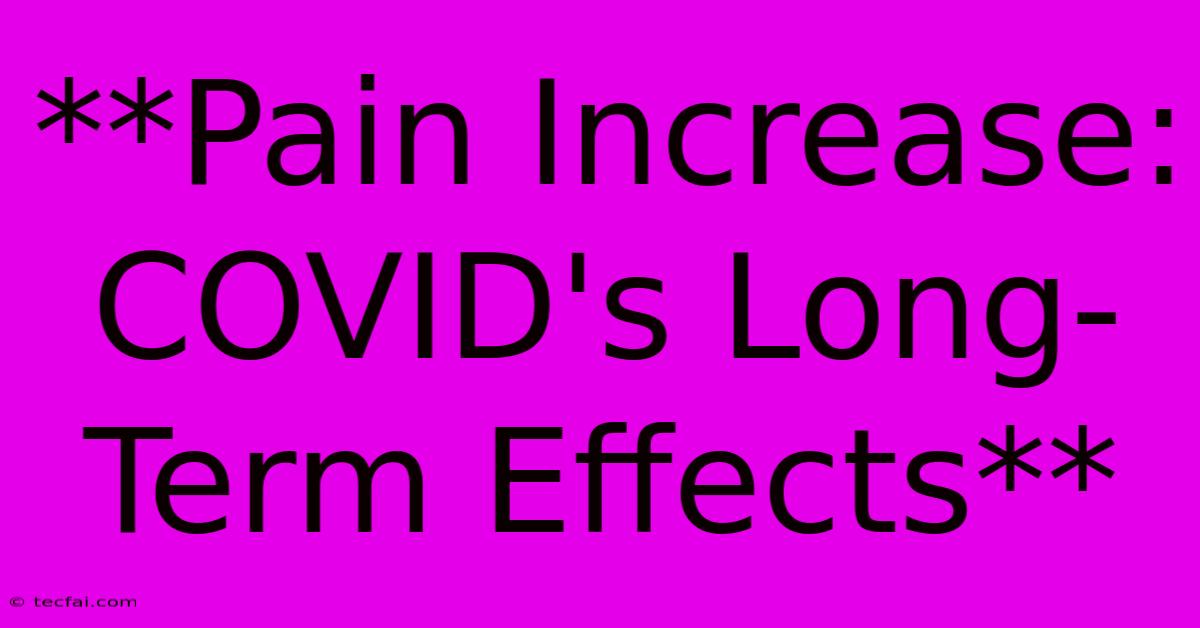**Pain Increase: COVID's Long-Term Effects**

Discover more detailed and exciting information on our website. Click the link below to start your adventure: Visit Best Website tecfai.com. Don't miss out!
Table of Contents
Pain Increase: COVID's Long-Term Effects
The COVID-19 pandemic has left a lasting impact on millions around the world, with many experiencing long-term health complications known as Long COVID. One of the most prevalent and debilitating symptoms of Long COVID is persistent pain, which can significantly impact quality of life. This article explores the connection between COVID-19 and increased pain, delving into potential causes, common pain types, and available treatment options.
Understanding the Link Between COVID-19 and Pain
The exact mechanisms behind Long COVID-induced pain are still being investigated, but researchers have identified several potential contributing factors:
- Inflammation: COVID-19 can trigger widespread inflammation throughout the body, potentially leading to chronic pain in various tissues and organs.
- Nervous system damage: The virus may directly affect the nervous system, causing nerve damage or dysfunction that manifests as pain.
- Autoimmune response: In some cases, the body's immune system may attack its own tissues following a COVID-19 infection, leading to chronic inflammation and pain.
- Psychological distress: The stress, anxiety, and isolation associated with COVID-19 and its long-term effects can contribute to increased pain perception.
Common Types of Pain in Long COVID
Pain associated with Long COVID can manifest in various forms, with some of the most common types including:
- Musculoskeletal pain: This includes pain in muscles, joints, tendons, and ligaments. It can affect areas like the back, neck, shoulders, and limbs.
- Headache: Persistent headaches, including migraines, are common in individuals with Long COVID.
- Chest pain: Pain in the chest area can be related to inflammation, lung damage, or even anxiety.
- Neurological pain: This includes pain that originates from the nervous system, such as burning, tingling, or numbness.
- Abdominal pain: Long COVID can also lead to persistent pain in the abdomen, potentially associated with gut inflammation or digestive issues.
Seeking Treatment and Managing Long COVID Pain
Managing pain associated with Long COVID requires a multidisciplinary approach, often involving a combination of:
- Pain management specialists: These professionals can assess the specific type and severity of pain, recommend appropriate treatments, and provide guidance on pain management strategies.
- Physical therapy: Physical therapists can help improve mobility, strength, and flexibility, which can alleviate pain and improve overall function.
- Occupational therapy: Occupational therapists can assist with adapting daily activities to minimize pain and improve functional independence.
- Medications: Pain relievers, anti-inflammatories, and other medications may be prescribed to manage pain symptoms.
- Mental health support: Addressing the psychological distress associated with Long COVID can be crucial in managing pain and improving overall well-being.
It's important to note that the information provided in this article is for general knowledge purposes only and should not be considered medical advice. Individuals experiencing persistent pain after a COVID-19 infection should consult with a healthcare professional for proper diagnosis and treatment. Early intervention and a personalized approach to pain management can significantly improve outcomes for individuals with Long COVID.

Thank you for visiting our website wich cover about **Pain Increase: COVID's Long-Term Effects**. We hope the information provided has been useful to you. Feel free to contact us if you have any questions or need further assistance. See you next time and dont miss to bookmark.
Featured Posts
-
Inter 1 0 Arsenal Calhanoglu Penalty Wins
Nov 07, 2024
-
Trump Speech Highlights Elon Musks Success
Nov 07, 2024
-
Costly Mistake Pl Teams Brain Freeze
Nov 07, 2024
-
Dali Mpofu Se Nuwe Politieke Tuiste
Nov 07, 2024
-
Jack Smiths Federal Cases Conclude
Nov 07, 2024
